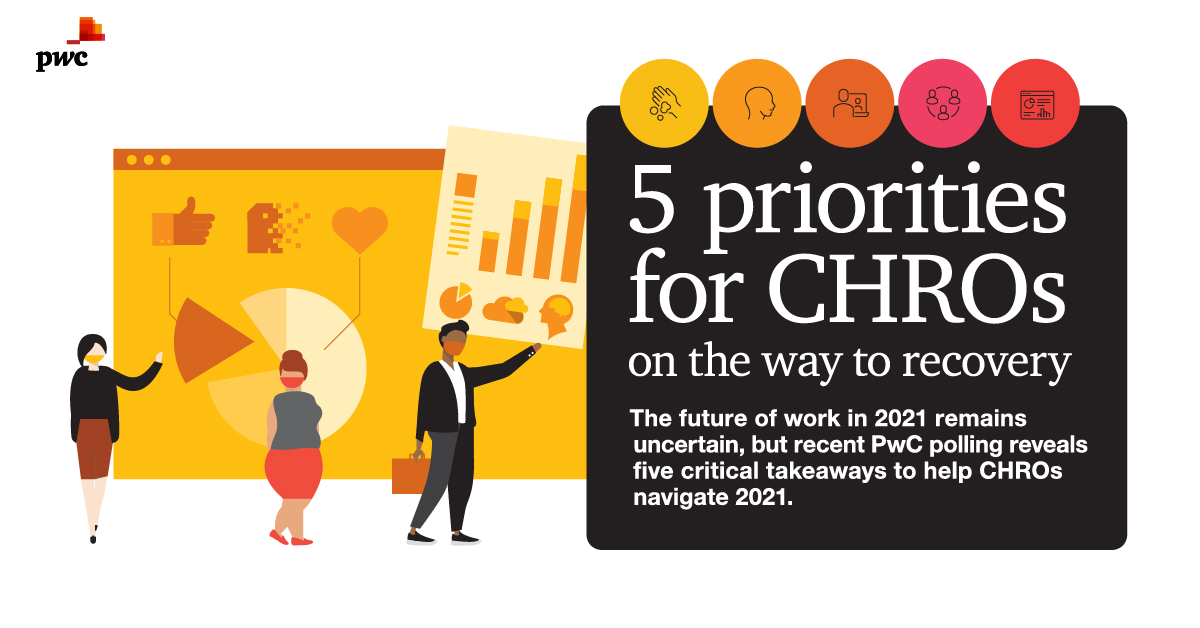Five Priorities for HR Leaders on the Way to Recovery
The following content is sponsored by PwC

Five Priorities for HR Leaders on the Way to Recovery
The future of the workplace remains uncertain, with business leaders facing unique hurdles heading into 2021. To help set the course, recent PwC reports reveal five key takeaways for Chief Human Resource Officers (CHROs) as businesses refine their recovery strategies and transition plans.
With polling data from thousands of U.S.-based employees and executives throughout 2020, the above graphic uncovers critical priorities to help HR leaders navigate 2021—from fostering workplace safety and well-being to implementing technology that promotes engagement.
Priority 1: Physical Safety, Comfort, Health & Performance
Employee anxiety is running high, with polls revealing that employees are concerned about getting sick—and the risk discourages them from returning to the workplace.
- 51% of employees fear getting sick from returning to the workplace
- 50% would like workplace safety measures established, to feel comfortable returning
- 45% would like safety and hygiene requirements implemented for customers
- 35% would like contact tracing to be used, with realtime notifications if a coworker is diagnosed with COVID-19
By implementing measures to keep employees healthy, employees may feel more confident as companies transition back into the workplace.
Priority 2: Supporting Mental Health & Wellness
Studies show that employees perform better when they have workplace flexibility—and they can thrive when leaders support their well-being. The importance of mental health and wellness at work has increased under the weight of the pandemic.
Polling found that:
- 36% of employees would like to see more humility, compassion, and empathic behaviors from their leadership
- 33% would like to to see corporate investment in wellbeing programs, which would make them more confident in their ability to do their job
- 72% would like to work remotely to some extent after the pandemic
- 84% of CHROs intend to increase support for wellbeing and mental health
Investing in mental health can pay dividends, with the World Health Organization reporting that for every dollar spent on mental health treatment, $4 is gained in productivity.
Priority 3: Enable Remote Work with the Right Tools & Training
As employees continue to work remotely, there’s a pressing need to upgrade technology and resources required to be productive, collaborative, and create.
- 55% of HR leaders were planning to implement hardware and equipment upgrades to help employees stay productive when working remotely
- 53% were planning for improved mobile experiences for applications and data, as well as security policies to support remote work
- Upwards of 36% of employees believed their organization was already very effective at collaboration and communication
With many organizations planning to incorporate some form of remote work into their long-term strategies, technology continues to be integral to support working remotely.
Priority 4: Maintain Organizational Culture for a Hybrid Workforce
Culture and engagement looked very different in the shifting landscape of 2020, and that will likely continue to evolve in 2021.
- 41% of CHROs worry about weakened work culture in the virtual world
- Nearly 50% have focused on employee productivity efforts on new virtual tools and training
- 80% are planning for new employee benefits
- 75% are planning for employee upskilling
While many remote employees report they may be more productive during the pandemic, CHROs should help confirm it’s sustainable in the long-term.
Priority 5: Leveraging Data Analytics
Studies show that better employee experiences can contribute to improved revenue growth, and PwC polls indicate that:
- 42% of CFOs are optimizing their approach to data analytics to improve revenue
- 35% are moving their applications and/or to the cloud
- 40% of workplace leaders are concerned about workplace safety
As executives experience concern over whether long-term remote work could impact engagement and productivity—focus has been placed on leveraging data analytics and digital assets to quantify and help inform corporate strategies.
Opportunities on the Road to Recovery
Even with COVID-19 vaccines on the horizon, uncertainty about the future of our work environments is high, posing unique challenges ahead for CHROs. However, those challenges can present strategic opportunities for work improvements—from digital assets and productivity, to mental health and well-being.
Note: All statistics are from the same PwC U.S. CFO Pulse survey unless otherwise stated. PwC surveyed 330 US CFOs and finance leaders between June 8-11, 2020. 88% percent of the respondents were from public and private companies in these top five sectors: health industries (9%), consumer markets (13%), financial services (23%), industrial products (23%), and technology, media and telecommunications (20%). Twenty-nine percent of respondents were from Fortune 1000 companies. The PwC CFO Pulse Survey is conducted on a periodic basis to track changing sentiment and priorities. Now in its sixth installment, the inaugural survey was conducted March 9-11, 2020.
-

 Sponsored3 years ago
Sponsored3 years agoMore Than Precious: Silver’s Role in the New Energy Era (Part 3 of 3)
Long known as a precious metal, silver in solar and EV technologies will redefine its role and importance to a greener economy.
-

 Sponsored7 years ago
Sponsored7 years agoThe History and Evolution of the Video Games Market
Everything from Pong to the rise of mobile gaming and AR/VR. Learn about the $100 billion video games market in this giant infographic.
-

 Sponsored8 years ago
Sponsored8 years agoThe Extraordinary Raw Materials in an iPhone 6s
Over 700 million iPhones have now been sold, but the iPhone would not exist if it were not for the raw materials that make the technology...
-

 Sponsored8 years ago
Sponsored8 years agoThe Industrial Internet, and How It’s Revolutionizing Mining
The convergence of the global industrial sector with big data and the internet of things, or the Industrial Internet, will revolutionize how mining works.


